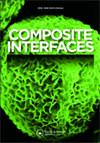用caco3 - sio2包封碳点制备超疏水荧光微/纳米复合材料
IF 2.4
4区 材料科学
Q3 MATERIALS SCIENCE, COMPOSITES
引用次数: 0
摘要
摘要本文以柠檬酸为原料,在聚乙烯亚胺(PEI)存在下,通过低温(<100℃)炭化法制备了聚胺功能化碳点(CDs),得到了反相微乳液体系中的球形碳酸钙微粒。采用Stöber法在微米级碳酸钙表面沉积制备了纳米级球形二氧化硅。扫描电镜和透射电镜分析证实了微/纳米复合结构,使复合材料涂层具有类似于“荷叶”的粗糙表面。经1 H、1 H、2 H、2 H全氟十硫醇改性后,水接触角为154.1°±1.5°,表面无能,荧光量子产率为14.1%,证实了该材料具有良好的超疏水性和荧光性能,为制备具有荧光特性的超疏水材料提供了一种廉价、简便的方法,促进了无机材料的高价值应用。关键词:复合材料;荧光;疏水性;欧文斯-温特模型披露声明作者未报告潜在利益冲突。本研究得到中丹盐湖化工产业链标准化体系教研研究中心[2019-GX-168]资助;甘肃省中小企业创新基金[1407GCCA013]。本文章由计算机程序翻译,如有差异,请以英文原文为准。
Superhydrophobic fluorescent micro-/nano-composites from carbon dots encapsulated in CaCO 3 -SiO 2
ABSTRACTIn this paper, polyamine-functionalized carbon dots (CDs) were synthesized by means of low temperature (<100°C) carbonization of citric acid at the presence of polyethylenimine (PEI), resulting spherical calcium carbonate micro-particles from inverse micro-emulsion system. Nanoscaled spherical silicas were prepared by Stöber method via deposition on the surface of micron calcium carbonate. Scanning- and transmission-electron microscopic analysis confirmed a micro-/nano-complex structure, enabling the composite material coating possessed coarser surface similar to those of ‘lotus leaf’. After modification with 1 H, 1 H, 2 H, 2 H-perfluorodecanethiol, both good super hydrophobicity and good fluorescent performance were confirmed by the water contact angle of 154.1°±1.5°, their surface-free energy, and fluorescence quantum yield of 14.1%, which provides an inexpensive and easy way to fabricate superhydrophobic material with fluorescence characteristics and promotes high value application of inorganic materials.KEYWORDS: Composite materialfluorescencehydrophobicityOwens-Wendt model Disclosure statementNo potential conflict of interest was reported by the author(s).Additional informationFundingThe work was supported by the Sino-Danish Center for Education and Research Research on Standardization System of Salt Lake Chemical Industry Chain [2019-GX-168]; Innovation Fund of Small and Medium-sized Enterprises of Gansu Province [1407GCCA013].
求助全文
通过发布文献求助,成功后即可免费获取论文全文。
去求助
来源期刊

Composite Interfaces
工程技术-材料科学:复合
CiteScore
5.00
自引率
3.80%
发文量
58
审稿时长
3 months
期刊介绍:
Composite Interfaces publishes interdisciplinary scientific and engineering research articles on composite interfaces/interphases and their related phenomena. Presenting new concepts for the fundamental understanding of composite interface study, the journal balances interest in chemistry, physical properties, mechanical properties, molecular structures, characterization techniques and theories.
Composite Interfaces covers a wide range of topics including - but not restricted to:
-surface treatment of reinforcing fibers and fillers-
effect of interface structure on mechanical properties, physical properties, curing and rheology-
coupling agents-
synthesis of matrices designed to promote adhesion-
molecular and atomic characterization of interfaces-
interfacial morphology-
dynamic mechanical study of interphases-
interfacial compatibilization-
adsorption-
tribology-
composites with organic, inorganic and metallic materials-
composites applied to aerospace, automotive, appliances, electronics, construction, marine, optical and biomedical fields
 求助内容:
求助内容: 应助结果提醒方式:
应助结果提醒方式:


